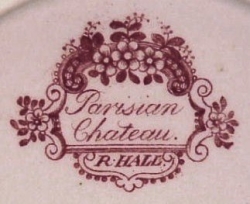 Ralph Hall and his son of the same name were successively involved as earthenware manufacturers in Burslem and Tunstall for just about the first fifty years of the 19th century.
Ralph Hall and his son of the same name were successively involved as earthenware manufacturers in Burslem and Tunstall for just about the first fifty years of the 19th century.
The first known documentary reference is in Allbut’s Map of Staffordshire Potters where ‘John & Ralph Hall’ are shown at Key 26, Burslem. Holden’s Directory of 1809 contains two separate entries for the firm, one at Burslem and one at Tunstall. Allbut’s Directory of 1822 evidences a separation of the business, showing John Hall at The Sytch, Burslem and Ralph Hall at Tunstall. The succession of the Directory entries together with the further evidence quoted below suggests that the business was founded by two brothers John and Ralph who each sired sons of the same name who succeeded to the separated parts of the business.
‘Mr John Mear (sic), Mr T. Goodfellow and Mr Ralph Hall, have elegant Mansions connected with extensive manufactories. Of Mr Hall, it may be justly stated, that his modest and unaffected piety, are exceeded only by his philanthropy and assiduity in every good work for public or private benefit’[1]
‘The Swan Bank Works is one of the oldest manufactories in Tunstall and belonged, in the beginning of the present century, to Ralph Hall…. Ralph Hall was succeeded by Podmore Walker & Co.’[2]
‘We pass on to (the dwelling house) of Mr Ralph Hall, the successor of a worthy father of the same name lately deceased, by whom this house was erected about thirty five years ago.’[3]
The Tunstall firm was originally styled Ralph Hall & Son but by 1841 was known as Ralph Hall & Co. The name change probably followed the death of Ralph Hall the elder in May 1838, at the age of 68.[4] The business closed in 1849, the Staffordshire Advertiser of 21st April of that year reporting that the manufactory with five ovens was to let; an auction of the factory stock was advertised in June of that year.
The firm was principally involved in the American export trade, a specialisation which predated the separation of the original business into two.[5] The surviving examples of its output demonstrate the changing fashions in the American trade over the life of the business. The early examples feature several series of blue printed wares of the intense deep blue popular in the 1820s, such as ‘Select Views’ and ‘Picturesque Scenery’. The later output was characterised by romantic rather than representational patterns printed in a range of ‘fancy’ colours.
To see Ralph Hall printed potery in this exhibit click here
[2] Llewellynn Jewitt ‘Ceramic Art of Great Britain’ 2nd Edition, J.S. Virtue & Co 1883, p.565.
[3] John Ward ‘The Borough of Stoke on Trent’ Lewis & Son 1843, p. 103
[4]‘Staffordshire Advertiser’ 19th May 1838.
[5] See the orders to the firm of John & Ralph Hall Burslem by Horace Collamore of Boston between 1814 and 1818, abstracted at Appendix 2 of ‘Staffordshire Ceramics and the American Market’ by Neil Ewins. Journal of Ceramic History, Volume 15, 1997.
